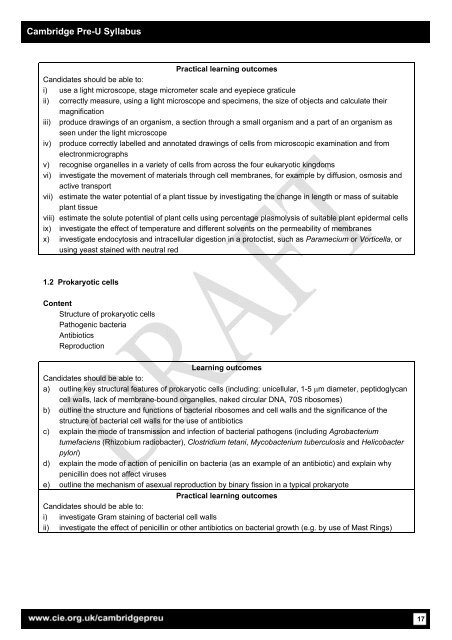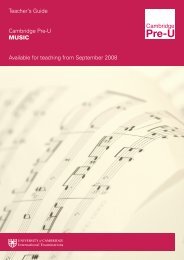Cambridge Pre-U Syllabus - Cambridge International Examinations
Cambridge Pre-U Syllabus - Cambridge International Examinations
Cambridge Pre-U Syllabus - Cambridge International Examinations
You also want an ePaper? Increase the reach of your titles
YUMPU automatically turns print PDFs into web optimized ePapers that Google loves.
<strong>Cambridge</strong> <strong>Pre</strong>-U <strong>Syllabus</strong><br />
Practical learning outcomes<br />
Candidates should be able to:<br />
i) use a light microscope, stage micrometer scale and eyepiece graticule<br />
ii) correctly measure, using a light microscope and specimens, the size of objects and calculate their<br />
magnification<br />
iii) produce drawings of an organism, a section through a small organism and a part of an organism as<br />
seen under the light microscope<br />
iv) produce correctly labelled and annotated drawings of cells from microscopic examination and from<br />
electronmicrographs<br />
v) recognise organelles in a variety of cells from across the four eukaryotic kingdoms<br />
vi) investigate the movement of materials through cell membranes, for example by diffusion, osmosis and<br />
active transport<br />
vii) estimate the water potential of a plant tissue by investigating the change in length or mass of suitable<br />
plant tissue<br />
viii) estimate the solute potential of plant cells using percentage plasmolysis of suitable plant epidermal cells<br />
ix) investigate the effect of temperature and different solvents on the permeability of membranes<br />
x) investigate endocytosis and intracellular digestion in a protoctist, such as Paramecium or Vorticella, or<br />
using yeast stained with neutral red<br />
1.2 Prokaryotic cells<br />
Content<br />
Structure of prokaryotic cells<br />
Pathogenic bacteria<br />
Antibiotics<br />
Reproduction<br />
Learning outcomes<br />
Candidates should be able to:<br />
a) outline key structural features of prokaryotic cells (including: unicellular, 1-5 µm diameter, peptidoglycan<br />
cell walls, lack of membrane-bound organelles, naked circular DNA, 70S ribosomes)<br />
b) outline the structure and functions of bacterial ribosomes and cell walls and the significance of the<br />
structure of bacterial cell walls for the use of antibiotics<br />
c) explain the mode of transmission and infection of bacterial pathogens (including Agrobacterium<br />
tumefaciens (Rhizobium radiobacter), Clostridium tetani, Mycobacterium tuberculosis and Helicobacter<br />
pylori)<br />
d) explain the mode of action of penicillin on bacteria (as an example of an antibiotic) and explain why<br />
penicillin does not affect viruses<br />
e) outline the mechanism of asexual reproduction by binary fission in a typical prokaryote<br />
Practical learning outcomes<br />
Candidates should be able to:<br />
i) investigate Gram staining of bacterial cell walls<br />
ii) investigate the effect of penicillin or other antibiotics on bacterial growth (e.g. by use of Mast Rings)<br />
17

















